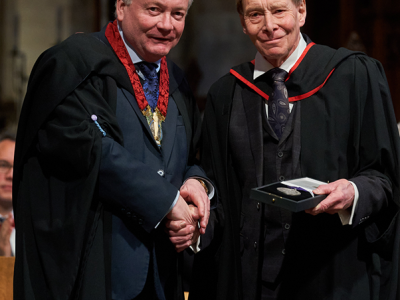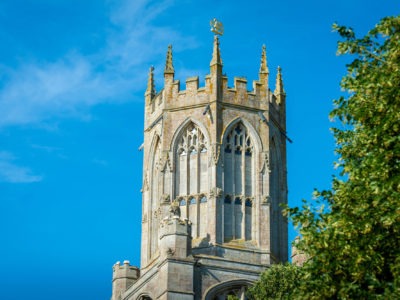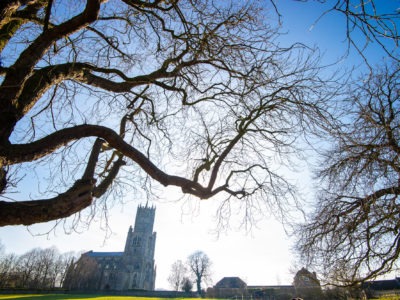Visit
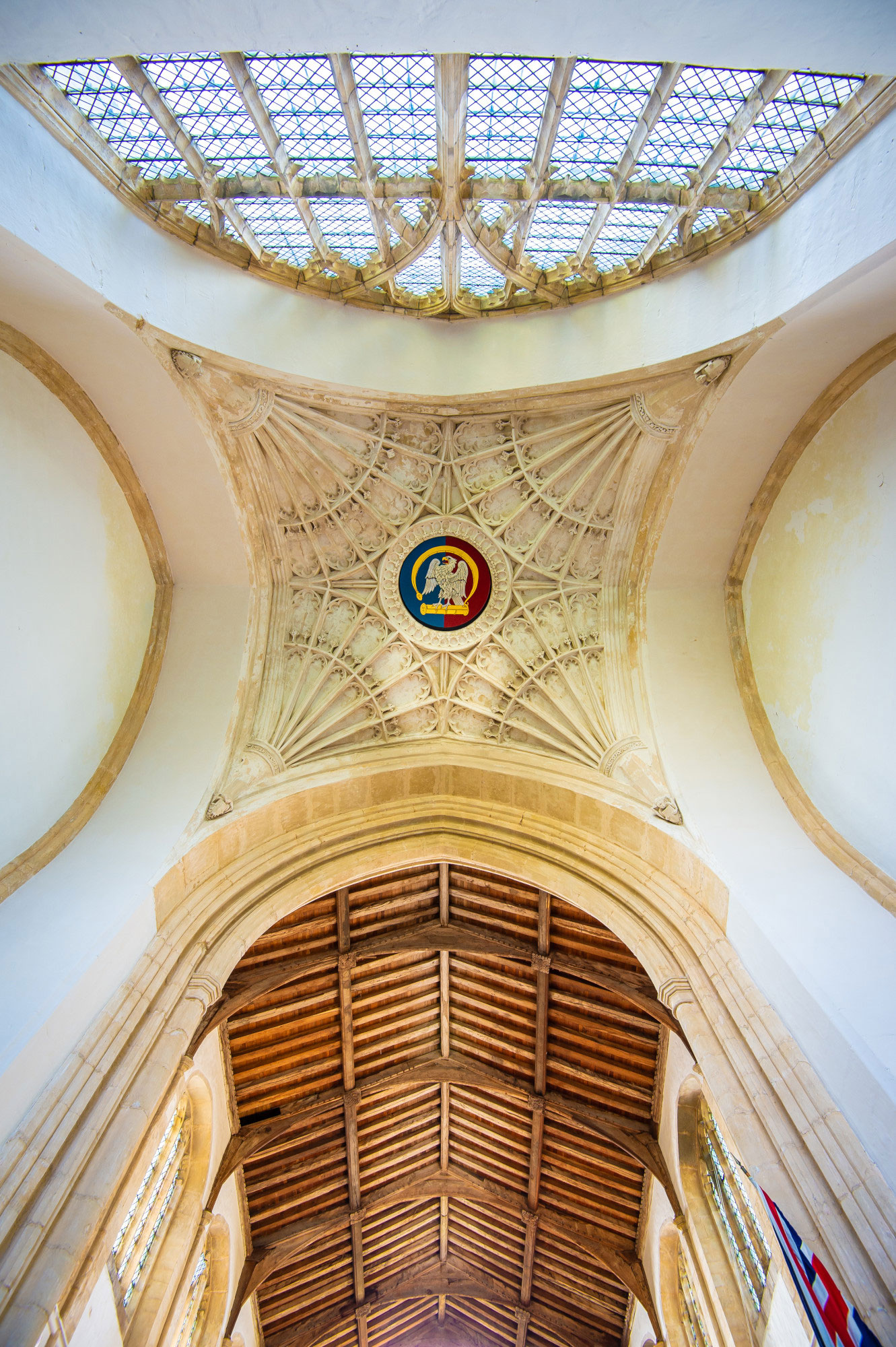
“On a warm summer’s day, Fotheringhay is a magic place. The church seems to float on its hill above the River Nene, a galleon of Perpendicular on a sea of corn.”
The Church of Saint Mary the Virgin and All Saints sits boldly at the heart of the village of Fotheringhay and is clearly visible from all approach roads.
Even the entrance gates at the start of the drive have a story to tell, having been demolished several times by errant drivers, one most recently distracted by spotting a rare bird in flight.
Entering the church through the north porch visitors are often struck not only by the size of the cavernous interior but just how light it is inside the building; a function of the ancient stained glass having been replaced centuries ago.
Prominent features to look out for include the 15th Century font, under the eastern arch of the tower, still used today, raised high on steps so that all the congregation can participate in the ceremony and topped with all that is left of the original misericords, featuring a joker’s cap.
Folklore has it that King Richard III may well have been baptised in the font, as he was born in Fotheringhay Castle in 1452.
Georgian Oak Box Pews sit either side of a wide nave area, installed in the early 19th Century at the behest of Thomas Belsey, a benefactor who purchased the territory of Fotheringhay in 1804 for the sum of £75,000; obviously a wealthy man in his day.
High above the arches and beneath the clerestory windows are the coats of arms of significant families associated with Fotheringhay and its church.
The 15th Century pulpit gifted to Fotheringhay Church by King Edward IV stands on a pedestal against the first pier of the north arcade. The pulpit is richly carved and ornamented, with emblems of Edward IV, the Duke of Clarence and Richard, Duke of Gloucester.
At the east end of the church is the Georgian Decalogue, or reredos as it forms a screen behind the altar, on which is inscribed the Apostles’ Creed, the Ten Commandments and the Lord’s Prayer.
The wooden week-day cross and candlesticks are modern and were made from bell-frame oak and the old bronze bell bearings, when the ancient bells were rehung in 1990.
Either side of the altar sit the Elizabethan tombs, commissioned after Elizabeth I visited the village in 1566. The monument on the right of the altar commemorates Edward, Second Duke of York, killed at the Battle of Agincourt in 1415 and on the left, his nephew, Richard, Third Duke of York, killed with his son Edmund, Duke of Rutland, at the Battle of Wakefield in 1460 and his wife Cecily Neville, known as The Rose of Raby.
The organ was installed in 2000. It is a mechanical action, two-manual pedal organ housed within a solid oak casing.
High over the eastern tower arch at the west end of the nave, near to the porch entrance, is a hatchment of the Royal Arms dating from the reign of George III.
The windows of the church originally contained remarkable images and icons reflecting its history. Few fragments survive and some are installed in the form of three window screens in the upper room of the tower. A close look at the aisle and clerestory windows reveals they are not totally clear but coloured, most evident when the sun shines. A new window, referred to as The York Window, dedicated in 1975, was a gift to the church from The Richard III Society and incorporates the arms of Richard III, Anne Neville, the Founders of the Collegiate Church, Benefactors and their wives.
Two sets of display boards, located in the South Aisle, recount one thousand years of Fotheringhay history, punctuated by the execution in Fotheringhay Castle of Mary, Queen of Scots in 1587.
The exterior of the church has many interesting historical and architectural features giving some insight into its dimensions when at its fullest extent and prior to the dismantling and demolition of the collegiate buildings at the hands of the Duke of Northumberland in 1548.
The Church is typically open from 9:30am until 5:00pm in spring summer months and otherwise closes at dusk.
Those journeying a significant distance should refer to the Warmington Benefice website for up-to-date information on opening and service times.
The church is open again to visitors each day from 9:30am to 5:00pm. A donation on your departure towards the upkeep of the church will be greatly appreciated.
www.warmingtonbenefice.org.ok
Latest news
Find the latest news and updates from The Friends of Fotheringhay Church, including updates on the Church of Saint Mary the Virgin and All Saints, as well as the village and surrounding area.
Plan a Visit
Experience Part of History
If you are looking to visit Fotheringhay, we can help provide you with all the information you need to plan out your visit and have the most enjoyable experience of the village, Church and surrounding areas. Learn more about the delightful landscape, sights and sounds of the local area, and the deep history of Fotheringhay village and the Church, so that when you arrive, you can truly get the most out of your visit.
Testimonials
“Whilst on a countryside walk, we stepped into this lovely church and were so glad that we did. Although a working church, there is also space for a small museum and the story of the church.”
“Glancing at the details of the church building and monuments, you know you are in King Richard III country and a place with royal historic connections.”
“A fascinating, and very old, church with useful information on the history of Fotheringhay and Mary Queen of Scots.”
“An unusual church, having lost over half its length when it's collegiate function was taken away during the reformation. The remaining building is high and wide with the seating in box pews.”
Plan a Visit
Experience Part of History
If you are looking to visit Fotheringhay, we can help provide you with all the information you need to plan out your visit and have the most enjoyable experience of the village, Church and surrounding areas. Learn more about the delightful landscape, sights and sounds of the local area, and the deep history of Fotheringhay village and the Church, so that when you arrive, you can truly get the most out of your visit.

